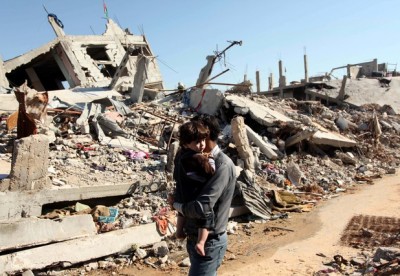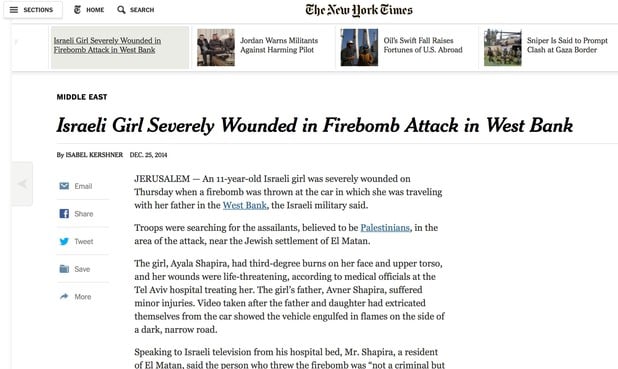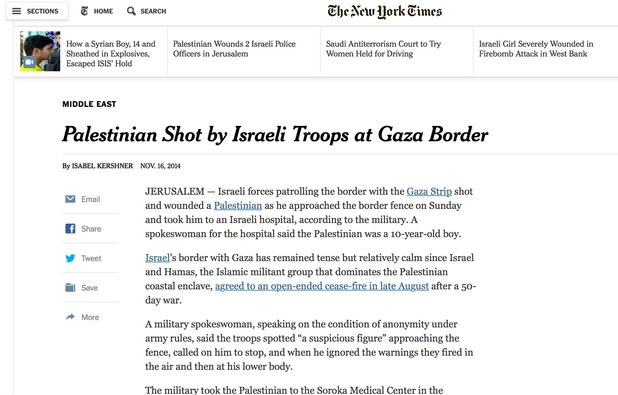How the New York Times Conceals Israeli Violence Against Palestinians

The massive upsurge of Israeli violence against Palestinians is invisible to The New York Times. (Ashraf Amra / APA images)
Two recent stories in The New York Times involve violence against Palestinian and Israeli children. But it is striking how differently the stories are treated based on the identity of the victim.
The first, from today, is headlined “Israeli Girl Severely Wounded in Firebomb Attack in West Bank.” The second, from November, is headlined “Palestinian Shot by Israeli Troops at Gaza Border.” Both are by Isabel Kershner.
Today’s report begins:
JERUSALEM — An 11-year-old Israeli girl was severely wounded on Thursday when a firebomb was thrown at the car in which she was traveling with her father in the West Bank, the Israeli military said.
Troops were searching for the assailants, believed to be Palestinians, in the area of the attack, near the Jewish settlement of El Matan.
The report names the girl – Ayala Shapira – and describes “third-degree burns on her face and upper torso” and says that her wounds were “life-threatening.”
Note how Kershner says the assailants are “believed to be” Palestinians – belief, not evidence. She also names the girl’s father and says he suffered light injuries, and quotes her mother.
The report then provides this, presumably as context:
There has been an uptick in Palestinian attacks against Israelis in recent weeks, including deadly assaults in Jerusalem, Tel Aviv and the Israeli-occupied West Bank. The violence has been fanned in part by a dispute over a revered holy site in Jerusalem.
Nowhere does the report state that there has been relentless violence by Israeli occupation forces and settlers against Palestinians.
The mention of a “revered holy site” also suggests the violence is religious and irrational in nature. It also erases the fact that Palestinians are subject to systematic Israeli violence, including ongoing home demolitions, forced displacement and land theft.
The tension over the “revered holy site” – Jerusalem’s al-Aqsa mosque – is the consequence of incursions by Israeli extremists, backed by the government, whoseultimate goal is to destroy it.
Huge surge in Israeli violence
In fact, though you wouldn’t know it from The New York Times, there has been a huge surge in violence against Palestinians.
“Palestinian civilians across the [occupied Palestinian territories] continue to be subject to various threats to their life, physical safety and liberty,” says the United Nations monitoring group OCHA in a year-end summary.
This year “witnessed the highest Palestinian casualty toll since 1967, primarily due to hostilities in Gaza,” OCHA adds.
But in the West Bank, too, there was a huge increase in Israeli violence: this year to date 49 Palestinians have been killed by Israeli forces in the occupied West Bank, almost double the number from last year, OCHA reports.
Ten of those killed in the West Bank were Palestinian children shot with live ammunition by Israeli occupation forces.
A staggering 5,771 Palestinians have been injured by Israeli forces in the West Bank this year, two thousand more than last year.
According to OCHA, Israel carried out an average of 96 “search and arrest” raids every week during the year, up from 75 per week in 2013. These assaults often take the form of night raids on homes, terrorizing entire families and communities.
This huge “uptick” in Israeli violence is invisible to The New York Times.
Boy shot in face
On Wednesday, a Palestinian boy aged five was shot in the face by Israeli occupation forces with a rubber-coated steel bullet, causing serious injuries.
The shooting occurred when Muhammad Jamal Ubeid and his fourteen-year-old sister were getting off a school bus in the eastern occupied Jerusalem neighborhood of Issawiyeh.
This tweet by Russia Today correspondent Paula Slier shows the boy in hospital with his parents, following surgery:
Tears and heartbreak few hours after surgery pic.twitter.com/jUu1TMKEUO
— Paula Slier (@PaulaSlier_RT) December 25, 2014
Just as this post was about to be published, Kershner filed a second report today, on an alleged stabbing of two Israeli police by a Palestinian in occupied Jerusalem.
It repeats the assertion that there has been a “recent increase in Palestinian attacks against Israelis.”
But Kershner found no room to mention the shooting of Muhammad Jamal Ubeid. (Update: shortly before this post was published, the Times published an AP report on its website about the stabbing of the Israeli police – the second on the same topic – which does mention the shooting of Ubeid. But it still does not appear in Kershner’s reports.)
“Palestinian” shot
Now let’s look at the other New York Times headline. It dates from 16 November: “Palestinian Shot by Israeli Troops at Gaza Border.”
Kershner’s report begins:
JERUSALEM — Israeli forces patrolling the border with the Gaza Strip shot and wounded a Palestinian as he approached the border fence on Sunday and took him to an Israeli hospital, according to the military. A spokeswoman for the hospital said the Palestinian was a 10-year-old boy.
Israel’s border with Gaza has remained tense but relatively calm since Israel and Hamas, the Islamic militant group that dominates the Palestinian coastal enclave, agreed to an open-ended cease-fire in late August after a 50-day war.
When you read the report, you learn that the “Palestinian” is reported to be a young boy. But the headline doesn’t say “Palestinian boy” the way today’s headline states “Israeli girl.”
Kershner relays the myth – or lie, if you will – that the situation in Gaza had been “relatively calm” since the 26 August ceasefire. In fact, Israel has been violating the ceasefire and firing on Palestinians there almost every day.
The boy is anonymous and we do not hear from his mother or father. But we learn he was taken to a hospital in Israel. The report continues:
A military spokeswoman, speaking on the condition of anonymity under army rules, said the troops spotted “a suspicious figure” approaching the fence, called on him to stop, and when he ignored the warnings they fired in the air and then at his lower body.
Here’s what Kershner provides, again presumably, for context:
A number of Palestinians have been arrested after crossing the border in the months since the cease-fire came into effect, including one in September who was found to have a knife.
In Jerusalem on Sunday, the police said they were searching for the assailant who stabbed a 32-year-old Israeli man with a screwdriver. The Israeli was being treated at a hospital.
Searching in the weekly reports from the Palestinian Centre for Human Rights, I found this incident on 16 November, which seems to most closely match the New York Timesreport, except that the age of the boy is 15, not ten:
At approximately 14:15, Israeli forces stationed along the border fence between the Gaza Strip and Israel, east of al-Bureij refugee camp in the central Gaza Strip, opened fire at Atiyah Fathi Atiyah al-Nabahin (15) living in the camp when he tried to infiltrate into Israel via the border fence. As a result, he was hit by a bullet to the neck and taken to Soroko Hospital in Beersheba. His injury was described as serious and he is still at the hospital receiving treatment.
Why Palestinians flee Gaza
It’s very likely al-Nabahin was trying to get across the fence to find work, or simply escape the dire situation in Gaza.
But The New York Times report places the entry attempt in the context of threats to Israel and attacks on Israelis and not the catastrophic and unprecedented violence that Israel has visited on Palestinians in Gaza.
The massive death and destruction and the economic depression caused by the ongoing siege are forcing Palestinians to risk their lives to flee Gaza in ever larger numbers, as the Israeli daily Haaretz has reported.
They risk their lives to flee by sea, where hundreds have perished or been deliberately drowned this year.
And increasing numbers risk their lives to flee across the Israeli fortifications – where like other escapees from history’s ghettos and internment camps – they risk being shot from watchtowers and patrols.
Indeed, reports state that two more Palestinians were shot trying to escape Gaza today.
None of this context was mentioned in The New York Times’ report.
The Times has to keep telling itself and its readers that Palestinians in general and those in Gaza in particular are the “threat” and Israel is playing defense.
That an entire population is being kept in a ghetto in Gaza, sealed off from the world and subjected to an incremental genocide, just to protect Israel’s alleged Jewish character, is, for many, a reality too awful to contemplate.
Those wishing to shield themselves from such truths should continue reading The New York Times.



